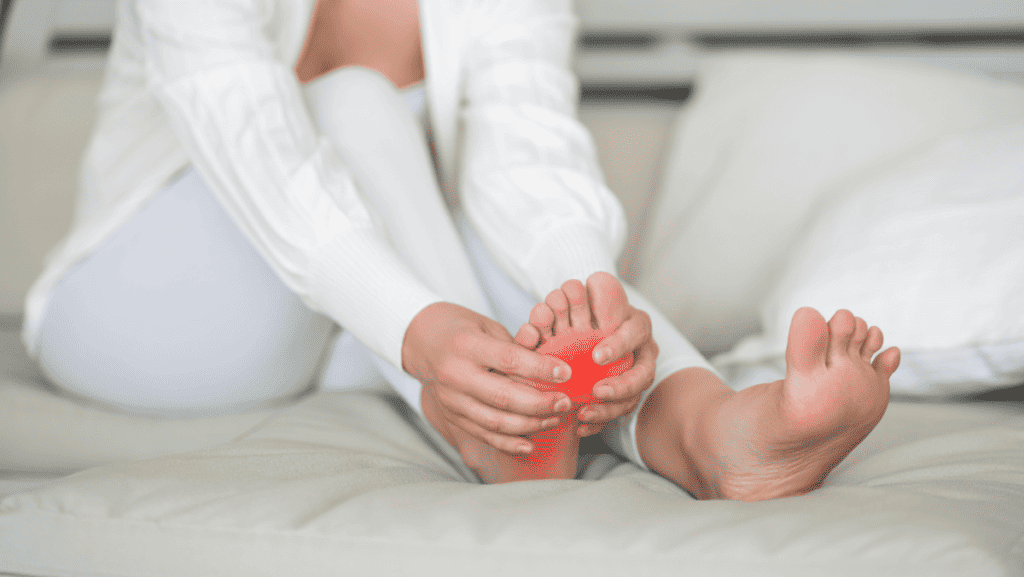10 Signs You May Have A Morton’s Neuroma
- Best Asics Shoes for Flat Feet - October 25, 2024
- Best Running Shoes for Flat Feet - October 22, 2024
- Posterior Tibial Tendonitis - October 21, 2024
Morton’s Neuroma is a painful condition affecting the ball of the foot, particularly between the third and fourth toes. The discomfort it causes can significantly limit one’s ability to stay active.
This condition is more common in middle-aged women, with a UK study revealing a prevalence of 50.2% in men and 87.2% in women per 100,000 patients seen in primary care. From my clinical experience, here are 10 key signs indicating you could have Morton’s Neuroma.
1. Localised Pain in the Forefoot
In the early stages, Morton’s Neuroma often presents as localised pain between the 3rd and 4th toes in the web space. This pain may start as a faint ache after activities like walking, standing, or other impact exercises. Many people overlook these early symptoms because they don’t occur daily, but as the condition progresses, the pain becomes more frequent and occurs sooner during physical activities.
2. Numbness or Tingling in the Toes
As Morton’s Neuroma affects the interdigital nerve, it leads to swelling and thickening of the surrounding fibrous tissue. This nerve compression can cause numbness or a pins-and-needles sensation in the 3rd and 4th toes or in the forefoot area. This symptom can be persistent or occur intermittently, especially during activity.
3. Radiating Pain
As the neuroma worsens, the pain may radiate from the web space into the 3rd and 4th metatarsals. This is more likely when the nerve is severely irritated due to compression, often triggered by walking, running, or other high-impact activities. The pain may linger after these activities, making it harder to stay active.

4. Narrow Shoes Increase Pain
Shoes with a narrow toe box, especially high heels, can aggravate Morton’s Neuroma significantly. When the toes are compressed, the nerve experiences more pressure, increasing inflammation and pain. High heels compress the toes and put extra force on the forefoot, making symptoms much worse.
If you’re looking for footwear that helps relieve these symptoms, check out our recommendations for the best shoes for Morton’s Neuroma.
5. Increased Pain with Activity
Physical activities like running, jumping, or playing sports (such as tennis or football) can increase the symptoms of Morton’s Neuroma. The repetitive impact and vibrations through the foot irritate the neuroma, leading to increased inflammation and discomfort. If you engage in such activities, you may notice your pain worsening during and after exercise.
6. Sensation of a Pebble in Your Shoe
One unique symptom of Morton’s Neuroma is the feeling of a pebble or stone stuck inside your shoe, even when there isn’t. This is caused by the neuroma becoming larger as the surrounding tissue thickens, leading to increased discomfort with each step.

7. Symptoms Gradually Worsen Over Time
If the factors that caused your neuroma—such as improper footwear or high-impact activities—are not addressed, the symptoms will likely get worse. Over time, the neuroma becomes more sensitive and irritable, making daily activities more challenging and painful.
8. Foot Cramps and Muscle Tightness
Pain in the ball of the foot often leads patients to subconsciously shift their weight away from the affected area, which can cause foot cramps and muscle tightness. This altered movement places additional stress on the foot’s smaller muscles and reduces the lengthening cycle of the calf during walking, leading to muscle strain.
9. Pain When Pressing Between Your Toes
The neuroma sits between the 3rd and 4th metatarsals in the web space, with little fatty or soft tissue for cushioning. Pressing or pinching this area can often cause sharp pain if you have Morton’s Neuroma. This is a telltale sign and may help in self-assessment.
10. Relief When Walking Barefoot
Since toe compression exacerbates Morton’s Neuroma, walking barefoot can provide relief by allowing the toes to spread naturally. This reduces the pressure on the neuroma and helps decrease pain. Wearing wide-fitting, cushioned shoes with insoles can also offer significant relief, allowing for more comfortable movement without aggravating the condition.
_______________________________________________________________________
Seeking Professional Help
If you’re experiencing any of these symptoms, it’s essential to seek medical advice to confirm the diagnosis of Morton’s Neuroma and discuss your treatment options. Proper footwear, physical therapy, and sometimes medical intervention are necessary to manage this condition effectively.
We specialise in treating foot conditions like Morton’s Neuroma. For expert care, you can book an appointment with one of our Foot and Ankle Specialists in Soho, London.
Feel Good, Move Well, Be Better
